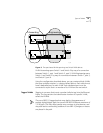
4
V
IRTUAL
LAN
S
(VLAN
S
)
Setting up Virtual Local Area Networks (VLANs) on the switch eases many
time-consuming tasks of network administration while increasing
efficiency in network operations.
This chapter describes the concept of VLANs and explains how to
implement VLANs on the switch.
Overview of Virtual
LANs
The term “VLAN” is used to refer to a collection of devices that
communicate as if they were on the same physical LAN. Any set of ports
(including all ports on the switch) is considered a VLAN. LAN segments
are not restricted by the hardware that physically connects them. The
segments are defined by flexible user groups you create with the
command-line interface.
Benefits
Implementing VLANs on your networks has the following advantages:
■
VLANs help to control traffic.
With traditional networks, congestion can be caused by broadcast
traffic that is directed to all network devices, regardless of whether
they require it. VLANs increase the efficiency of your network because
each VLAN can be set up to contain only those devices that must
communicate with each other.
■
VLANs provide extra security.
Devices within each VLAN can only communicate with member
devices in the same VLAN. If a device in VLAN
Marketing
must
communicate with devices in VLAN
Sales
, the traffic must cross a
routing device.


















